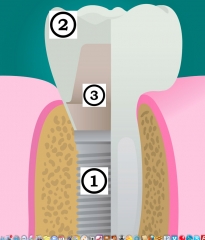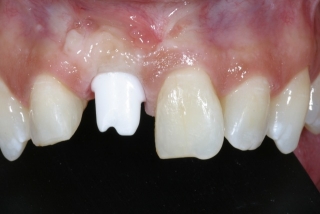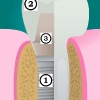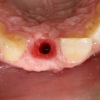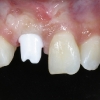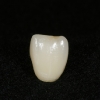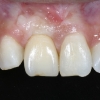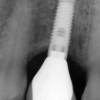If you are confused about what goes on top of a dental implant after it is placed, you are not alone. Questions like: how many components are there? what is an abutment? how does the crown fit into it all? what kind of abutment and crown will be placed?
And the question: Do you really need to worry about all of these?
The answer is ABSOLUTELY YES.
The fact is not all abutments and crowns are created equal. Typically, following the placement of a dental implant, patients must return to their restorative dentist to have the final abutment and crown made. The type and shape of the abutment and crown is critical in achieving longevity and success with the aesthetic and functional results you expect. But far too often, poor abutment and crown designs lead to compromised results and unhappy patients. For best results, make sure your restorative dentist uses a customized abutment for your dental implant. Let’s first review some basics:
A dental implant-supported tooth is made of three parts:
- The dental implant: This is the foundation which supports the overlying abutment and crown.
- The crown: This is the actual tooth that you see.
- The abutment: The abutment is attached to the implant and supports the overlying crown.
There are two types of abutments: Custom and stock (pre-fabricated.)
- Custom abutments are made by a dental laboratory. The restorative dentist captures the position of the implant and the shape of the surrounding gum tissue by taking an impression. The laboratory then fabricates an abutment that resembles the emergence and shape of a natural tooth. The custom abutment will fit perfectly on the implant and supports the gum tissue similar to a natural tooth.
- Stock abutments are manufactured by dental implant companies. Although such pre-fabricated abutments fit well into the implant, they rarely offer proper shape and form. The results are often over-contoured or under-contoured abutments that do not shape the gum tissue properly and create a very unnatural appearance of the crown. Patients often complain of poor aesthetics, ‘dark’ margins, and difficulty with cleaning them.
What should you do as a patient?
- Ask your dentist what type of abutment is planned. Make sure that they give you a custom abutment. This is simply done by taking an impression of your dental implant and sending it to a laboratory to be processed. A low cost dental implant deal may be a good indication that stock abutments are being used instead of custom abutments, as pre-fabricated stock abutments are less costly to the dentist.
- Ask what type of crown they are making. Depending on the area of the mouth and location of the implant, you have choices of all ceramic crowns vs. porcelain-fused to metal crowns. In the smile zone, all ceramic abutments and crowns are more commonly used, while in back of the mouth, titanium abutments with porcelain-fused to metal crowns generally work quite well.
Check out this photo gallery for examples:
